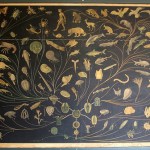biology
One of the holy grails of modern astrophysics is to find a planet orbiting another star that can support life on it. There are all sorts of missions dedicated to searching for habitable worlds.
But with one star system, Gliese 581, we may have hit the jackpot. To look at Gliese 581 in the sky, it doesn't look like much.
It's a red dwarf star, and a much smaller star than our own Sun. It weighs in at only about 30% of the mass and size of our Sun, and it's estimated to be twice as old. But at only 20 light-years from us, it's pretty close, for another star.
So what makes it so important?
It'…
Every day, it seems, we find out that what we thought we knew about flu isn't the case. As one noted flu expert said to me once, "I knew much more about flu 20 years ago than I do now." So it's good to remember that we are also finding out a lot about flu that we never knew or even thought we knew. A case in point is an extremely important new paper in PLoS Medicine ( Khurana S, Suguitan AL Jr., Rivera Y, Simmons CP, Lanzavecchia A, et al.(2009) Antigenic Fingerprinting of H5N1 Avian Influenza Using Convalescent Sera and Monoclonal Antibodies Reveals Potential Vaccine and Diagnostic Targets.…
As apex organisms in the scope of Earth's multi-tiered web of life, most of us go about our day-to-day activities oblivious to the fact that bacteria are literally everywhere. Microorganisms can thrive in the most surprising locales—places totally inhospitable to human life. Recently, scientists from Harvard documented a flourishing bacterial ecosystem buried under 400 meters of ancient glacial ice; more common bacteria, Salmonella may lurk on your dinner plate, as a report citing 48,600 infections across ten states in 2008 attests; and if it's any indication from this scientific pursuit,…
We all know Twitter can be annoying, but is it really evil? During the past week, you may have heard that there is brand-new neuroscientific evidence proving exactly that. But the hype turns out to be just that: hype.
It all started with a press release from USC about an upcoming PNAS paper by Mary Helen Immordino-Yang and Antonio Damasio, entitled "Neural Correlates of Admiration and Compassion." The USC press release, which was picked up by EurekAlert and other outlets, says:
The finding, contained in one of the first brain studies of inspirational emotions in a field dominated by a focus…
How old is the Solar System? We know now, from a variety of astronomical, geological and solar evidence that we're looking at about 4.5 billion years. But in the 19th century, there was a huge problem. Here's why.
On one hand, you had evolutionary biology and evolutionary biologists.
Charles Darwin had discovered not only that organisms evolve, but had determined the mechanism of natural selection. His voyage on the HMS Beagle had allow him to make the observations necessary to confirm the validity of his theory and its mechanism.
A little bit about geology and the age of the Earth was known…
You've never heard "in real time" screamed with so much passion. Not just one, but two big-haired metal-band bio-rock videos after the fold. . .
(sources: here and here)
The news of a new antiviral comes at a Press Conference. That could either mean a blockbuster breakthrough or an unwarranted device to get attention for some otherwise decent but not blockbuster science. Unfortunately, the news that "Experts Identify Compound That May Fight Bird Flu" is of the second type:
Scientists in Hong Kong and the United States have identified a synthetic compound which appears to be able to stop the replication of influenza viruses, including the H5N1 bird flu virus.
The search for such new "inhibitors" has grown more urgent in recent years as drugs, like oseltamivir…
Click here for more video book reviews by Joanne Manaster.
No, it's not how evolution really works, but it's awfully cool anyway.
The Experiment from Colin Trenter on Vimeo.
I love Photoshop, but am I the only one who thinks this resembles a cross between a Rorschach test and a SyFy Channel commercial?
This critter is Pogonomyrmex maricopa, a species of harvester ant which is apparently famous for having the most venemous sting of any North American insect. One sting from the Maricopa Harvester Ant is equivalent to twelve honey bee stings. Best of all, it's native to here in Arizona. Just one of the things that I didn't know that I learned over at Alex Wild's latest post. The photo is by him as well.
This detailed medical illustration by the late Duncan Winter shows the advantages of a good medical illustration over a typical photograph. There are no problems with over- or under-exposure, no depth-of-field issues, and the salient features are subtly emphasized. The underside in particular is very impressive work - there's a lot going on down there and it's really tough to draw clearly.
From the medical illustration flickrset by Bottled Monsters
This beautiful painting is located in Martin Hall at Swarthmore College. Discovered via Colin Purrington's flickr feed.
Zea Poster from m f's flickr stream
Michael Franklin, Rochester Institute of Technology
One of the ways in which I can foresee Web 2.0 applications changing the culture of science is by increasing avenues for mentorship. Web apps allow students from different departments, universities, and nations to connect, collaborate, and exchange advice. This can mean career-changing help for students at small institutions (or for those at large institutions with poor interdepartmental relations or a dearth of experts in a particular field). I'm not just talking about help troubleshooting protocols; far…
Frequent commenter, sibling, and bon vivant Uncle Fishy recently set up a backyard beehive, but lately he's been worried about the bees. This came up in a recent online chat:
Dr. Free-Ride: So, what's worrisome about your bees?
Uncle Fishy: i dont know if they'll make it
Dr. Free-Ride: :-(
Uncle Fishy: there were fewer coming out to sting me last night
Uncle Fishy: maybe it was just past their bedtime
Dr. Free-Ride: Maybe they had better things to do than sting you again
Uncle Fishy: well, I may be attriting more of them that I need
Uncle Fishy: I may not yet have a queen
Dr. Free-Ride: Uh…
More or less alongside my piece on depression's wiring diagram, this months' Scientific American Mind has a piece I wrote on how social hierarchies develop among rats.
Darlene Francis, a psychologist at the University of California, Berkeley, placed 80 newly weaned rats in cages of four, with cage mates matched for size, activity level and early life environment. To Francis's amazement, it took weeks--until the rats were well past puberty--for a social hierarchy to evolve (as indicated by which mouse got first dibs at food and water, among other measures). Perhaps more surprising was that…
Let me give you a little back story. As many of you know, I'm new to scienceblogs, and one of the first things we get to do is join a message board full of all the bloggers (sciblings) here. Well, suffice it to say, a contentious discussion took place between me and another scibling, which resulted in my being called a total n00b in front of the entire world.
So, what better way to make peace than by having me -- an astrophysicist -- answer a question about physiology?! Let's take a look at what I've got, since I'm a frequent solicitor of questions:
Why is my pee yellow in the morning, but…
New anatomical DIY project: get a CT scan, remix it to music, and post it on the web! That's what Jaymis did:
Inside The Jaymis: Skeleton Animation - Wide Time from Jaymis on Vimeo.
I got an MRI recently, but they didn't give me the results on a CD, so I can't do this. Now I feel all left out. Nevertheless, it's kind of odd looking at someone else's innards on a Sunday morning over tea. . . is this DIY TMI?
Via Andrew Sullivan.
Fixed Heart
offal with mixed metal components
Lisa Black, 2008
I blogged about New Zealand artist Lisa Black before, but I can't get over this great piece of hers. What does it signify? Does it represent the gradual replacement of the natural world around us with technology, to the point where our own bodies become artificial? Is it critiquing the reductionist tendencies of neurobiologists who believe our deepest emotions are complex but purely chemical reactions? Is it a steampunk Valentine? I don't know, and I don't really care - it's just cool.
Check out more from Black here.
If you had a prowler at your house you'd call the police. You'd want them to come. But what if they sent a SWAT Team, surrounded the house and blasted it from all sides. Not good. That seems to be something like the scenario for a response to a class of virulent influenza viruses. They trip the alarm and the army descends and levels the house. The prowler is taken care of. So are you. The phenomenon has acquired the name "cytokine storm," although a better description might be immune system dysregulation. Your immune system has a lot of powerful weapons to protect you, but like a police force…







